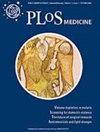羟氯喹或氯喹预防 COVID-19 (COPCOV) 的评估:双盲、随机、安慰剂对照试验。
IF 9.9
1区 医学
Q1 MEDICINE, GENERAL & INTERNAL
引用次数: 0
摘要
背景羟氯喹(HCQ)被证明对冠状病毒病 2019(COVID-19)住院患者的治疗效果不佳,但其在化学预防方面的安全性和有效性仍存在不确定性。之前的化学预防随机对照试验(RCT)并未单独显示 HCQ 对 COVID-19 的益处,尽管荟萃分析表明 HCQ 有临床益处,但指南建议不要使用 HCQ。HCQ在欧洲和非洲进行了评估,氯喹(CQ)在亚洲进行了评估(两种药物的基础剂量均为155毫克,每天一次)。主要终点是在 3 个月的随访期间通过 PCR 或血清转换确认有症状的 COVID-19。二级和三级终点为:实验室确诊的无症状严重急性呼吸系统综合征冠状病毒 2(SARS-CoV-2)感染;COVID-19 症状的严重程度;PCR 确诊的全因无症状急性呼吸道疾病(包括 SARS-CoV-2 感染);参与者报告的损失工作日数;与有症状的 COVID-19、呼吸道疾病和疾病严重程度相关的基因和基线生化指标(未在此报告);以及 HCQ 和 CQ 预防性治疗对成本和生活质量的健康经济学分析(未在此报告)。主要分析和安全性分析在意向治疗(ITT)人群中进行。原计划招募40,000名参与者(20,000名HCQ组,20,000名CQ组),但由于对使用HCQ的疗效和不良事件的争议、疫苗在一些国家的推广以及其他因素导致的长期延误而未能实现。在 2020 年 4 月 29 日至 2022 年 3 月 10 日期间,共有 4652 名参与者(46% 为女性)参加了研究(HCQ/CQ n = 2320;安慰剂 n = 2332)。年龄中位数(IQR)为 29(23 至 39)岁。有 1,071 人(23%)感染了 SARS-CoV-2(无症状和无症状)。在主要终点方面,有症状的 COVID-19 发生率在 HCQ/CQ 组为 240/2,320 例,安慰剂组为 284/2,332 例(风险比 (RR) 为 0.85 [95% 置信区间为 0.72 至 1.00; p = 0.05])。在二级和三级结果中,11.5% 的 HCQ/CQ 接受者和 12.0% 的安慰剂接受者出现无症状 SARS-CoV-2 感染:RR:0.96(95% CI,0.82 至 1.12;P = 0.6)。两组患者的症状严重程度没有差异,也没有出现严重疾病。HCQ/CQ 化学预防与较少的 PCR 证实的全因呼吸道感染(主要是 SARS-CoV-2)有关:RR 0.61(95% CI,0.42 至 0.88;p = 0.009),因病缺勤天数减少:90 天内每千名参与者缺勤 104 天(95% CI,12 至 199 天;p < 0.001)。对所有已发表的暴露前 RCT 进行的预设荟萃分析表明,HCQ/CQ 预防可为症状性 COVID-19 提供中等程度的保护性益处:RR为0.80(95% CI,0.71至0.91)。两种药物的耐受性都很好,没有发生与药物相关的严重不良事件(SAE)。研究的局限性包括:研究规模小于计划规模,PCR确诊的感染人数相对较少,血清学终点(尤其是改良的干血斑法)与PCR终点相比准确性较低。COPCOV试验已在ClinicalTrials.gov上注册,编号为NCT04303507。在这项大型安慰剂对照双盲随机试验中,HCQ和CQ在COVID-19化学预防中安全且耐受性良好。试验注册ClinicalTrials.gov NCT04303507;ISRCTN Registry ISRCTN10207947。本文章由计算机程序翻译,如有差异,请以英文原文为准。
Evaluation of hydroxychloroquine or chloroquine for the prevention of COVID-19 (COPCOV): A double-blind, randomised, placebo-controlled trial.
BACKGROUND
Hydroxychloroquine (HCQ) has proved ineffective in treating patients hospitalised with Coronavirus Disease 2019 (COVID-19), but uncertainty remains over its safety and efficacy in chemoprevention. Previous chemoprevention randomised controlled trials (RCTs) did not individually show benefit of HCQ against COVID-19 and, although meta-analysis did suggest clinical benefit, guidelines recommend against its use.
METHODS AND FINDINGS
Healthy adult participants from the healthcare setting, and later from the community, were enrolled in 26 centres in 11 countries to a double-blind, placebo-controlled, randomised trial of COVID-19 chemoprevention. HCQ was evaluated in Europe and Africa, and chloroquine (CQ) was evaluated in Asia, (both base equivalent of 155 mg once daily). The primary endpoint was symptomatic COVID-19, confirmed by PCR or seroconversion during the 3-month follow-up period. The secondary and tertiary endpoints were: asymptomatic laboratory-confirmed Severe Acute Respiratory Syndrome Coronavirus 2 (SARS-CoV-2) infection; severity of COVID-19 symptoms; all-cause PCR-confirmed symptomatic acute respiratory illness (including SARS-CoV-2 infection); participant reported number of workdays lost; genetic and baseline biochemical markers associated with symptomatic COVID-19, respiratory illness and disease severity (not reported here); and health economic analyses of HCQ and CQ prophylaxis on costs and quality of life measures (not reported here). The primary and safety analyses were conducted in the intention-to-treat (ITT) population. Recruitment of 40,000 (20,000 HCQ arm, 20,000 CQ arm) participants was planned but was not possible because of protracted delays resulting from controversies over efficacy and adverse events with HCQ use, vaccine rollout in some countries, and other factors. Between 29 April 2020 and 10 March 2022, 4,652 participants (46% females) were enrolled (HCQ/CQ n = 2,320; placebo n = 2,332). The median (IQR) age was 29 (23 to 39) years. SARS-CoV-2 infections (symptomatic and asymptomatic) occurred in 1,071 (23%) participants. For the primary endpoint the incidence of symptomatic COVID-19 was 240/2,320 in the HCQ/CQ versus 284/2,332 in the placebo arms (risk ratio (RR) 0.85 [95% confidence interval, 0.72 to 1.00; p = 0.05]). For the secondary and tertiary outcomes asymptomatic SARS-CoV-2 infections occurred in 11.5% of HCQ/CQ recipients and 12.0% of placebo recipients: RR: 0.96 (95% CI, 0.82 to 1.12; p = 0.6). There were no differences in the severity of symptoms between the groups and no severe illnesses. HCQ/CQ chemoprevention was associated with fewer PCR-confirmed all-cause respiratory infections (predominantly SARS-CoV-2): RR 0.61 (95% CI, 0.42 to 0.88; p = 0.009) and fewer days lost to work because of illness: 104 days per 1,000 participants over 90 days (95% CI, 12 to 199 days; p < 0.001). The prespecified meta-analysis of all published pre-exposure RCTs indicates that HCQ/CQ prophylaxis provided a moderate protective benefit against symptomatic COVID-19: RR 0.80 (95% CI, 0.71 to 0.91). Both drugs were well tolerated with no drug-related serious adverse events (SAEs). Study limitations include the smaller than planned study size, the relatively low number of PCR-confirmed infections, and the lower comparative accuracy of serology endpoints (in particular, the adapted dried blood spot method) compared to the PCR endpoint. The COPCOV trial was registered with ClinicalTrials.gov; number NCT04303507.
INTERPRETATION
In this large placebo-controlled, double-blind randomised trial, HCQ and CQ were safe and well tolerated in COVID-19 chemoprevention, and there was evidence of moderate protective benefit in a meta-analysis including this trial and similar RCTs.
TRIAL REGISTRATION
ClinicalTrials.gov NCT04303507; ISRCTN Registry ISRCTN10207947.
求助全文
通过发布文献求助,成功后即可免费获取论文全文。
去求助
来源期刊

PLoS Medicine
医学-医学:内科
CiteScore
21.60
自引率
0.60%
发文量
227
审稿时长
3 months
期刊介绍:
PLOS Medicine aims to be a leading platform for research and analysis on the global health challenges faced by humanity. The journal covers a wide range of topics, including biomedicine, the environment, society, and politics, that affect the well-being of individuals worldwide. It particularly highlights studies that contribute to clinical practice, health policy, or our understanding of disease mechanisms, with the ultimate goal of improving health outcomes in diverse settings.
Unwavering in its commitment to ethical standards, PLOS Medicine ensures integrity in medical publishing. This includes actively managing and transparently disclosing any conflicts of interest during the reporting, peer review, and publication processes. The journal promotes transparency by providing visibility into the review and publication procedures. It also encourages data sharing and the reuse of published work. Author rights are upheld, allowing them to retain copyright. Furthermore, PLOS Medicine strongly supports Open Access publishing, making research articles freely available to all without restrictions, facilitating widespread dissemination of knowledge. The journal does not endorse drug or medical device advertising and refrains from exclusive sales of reprints to avoid conflicts of interest.
 求助内容:
求助内容: 应助结果提醒方式:
应助结果提醒方式:


